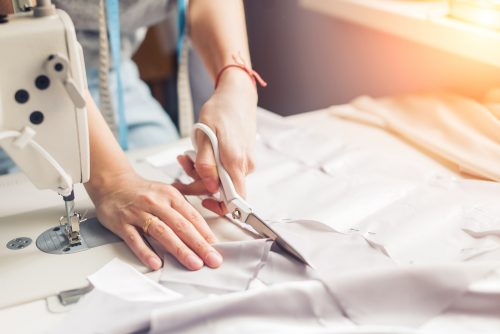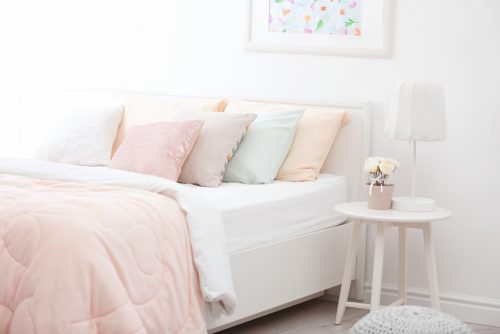4 of the Latest Designs to Make your own Bedding

Would you like to be able to make your own bedding? What a great idea! First of all, you need to know the basics of making bedding, and then you can decide what design to use or what type of fabric you prefer.
In the following article, you can find out how to make your bedding yourself, using patterns that are trending these days.
How to make your own bedding
Making things for yourself is really quite satisfying, especially when what you make is useful and practical. In the case of bedding, it’s not a particularly simple task, but it’s well worth it. Once you have a bit of experience, you could make sheets and blankets for family and friends (or even start up your own home business).
The materials you will need to make your own bedding are:
- Sewing machine
- Scissors, pins, a measuring tape, needles
- Fabric that’s 2.4 meters wide (for a single bed you’ll need 3.75 meters in length and for a double bed fabric 5 meters in length)
- Thread the same color as the fabric
- A meter of thin elastic

Steps to make bedding
When you’ve got all the materials together to make your own bedding, here are the steps you will need to take:
Start with the pillowcases. These are smaller and easier to make. You should cut a piece of fabric 0.55 x 1.6 meters for each pillow you want to cover. Make a 5 cm hem around the edge. Fold it in half and sew along the long side with the folded edges and one of the short sides.
Next, make the top sheet. To do this, you should cut a piece of fabric 1.7 meters for a single bed, or 2.2 meters if it’s a double bed. Make a hem all around the border, of 10 centimeters. If you want to make a blanket the process is the same, except that the dimensions of the blanket should be a little bigger. Make it at least 20 centimeters bigger if you want it to just cover the top sheet, or bigger if you want it to reach to the floor. The material you need for blankets will also be different.
For the fitted sheet or bottom sheet, you should cut the fabric to 1.5 meters or to 1.9 meters depending on whether the bed is single or double. At each corner, cut out a square of 25 x 25 centimeters and sew up the two remaining sides to make the fitted corners. Make a hem of 2 centimeters in all four corners to insert the elastic. Then sew up the ends so the elastic doesn’t move around. Lastly, make a hem all around the edge of the fabric.
Trends in bedding
Now that you know how to make your own bedding, the next step is… choose the fabric! And what better way to make your choice than to be up to date with the latest trends in sheets and bedrooms? There is a huge variety of designs and colors that you can find in the shops. Take particular note of the following:
1. Bright prints
Striking colors and attention-grabbing designs for the bedroom are the latest trends. They are often used in rooms that aren’t overdecorated, where the focus is on the bed.
This is an excellent way to transmit sensations, give comfort and without doubt create a bedroom decor that’s based more aesthetic than practical.
The downside is that for some people, having a bed with very colorful and attention-grabbing sheets is detrimental to their rest. This can especially be the case if the colors used are dark or if the print patterns are very complex. Make sure you choose a design that’s right for you.
2. Pastel colors
They aren’t just for kids’ bedrooms. Pastel colors are being used more and more in the latest decor trends. They have a relaxing effect and are ideal for a restful atmosphere.
If you like Nordic or romantic decor, this bedding fabric would be perfect for you!

3. Soft prints
This can mean a white sheet with printed flowers, or elegant geometric shapes. You can find many print designs of fabrics with busy or less busy patterns. The fabric should always have a light color as the background.
4. Rustic designs
A rustic style decor for the bedroom not only includes the printed design of the fabric but also the type of fabric you choose for your bedding. You can find certain fabrics that seem ‘wrinkled’ but are soft to touch and are ideal for blankets or bedspreads.
Fabrics available to make bedding can be as varied as the bedrooms themselves. If you want to sew your sheets for the first time, we recommend you buy fabric that’s easy to cut and simple to work with. Also, on some occasions, printed fabrics could help to ‘hide’ defects in the seams.
Would you like to be able to make your own bedding? What a great idea! First of all, you need to know the basics of making bedding, and then you can decide what design to use or what type of fabric you prefer.
In the following article, you can find out how to make your bedding yourself, using patterns that are trending these days.
How to make your own bedding
Making things for yourself is really quite satisfying, especially when what you make is useful and practical. In the case of bedding, it’s not a particularly simple task, but it’s well worth it. Once you have a bit of experience, you could make sheets and blankets for family and friends (or even start up your own home business).
The materials you will need to make your own bedding are:
- Sewing machine
- Scissors, pins, a measuring tape, needles
- Fabric that’s 2.4 meters wide (for a single bed you’ll need 3.75 meters in length and for a double bed fabric 5 meters in length)
- Thread the same color as the fabric
- A meter of thin elastic

Steps to make bedding
When you’ve got all the materials together to make your own bedding, here are the steps you will need to take:
Start with the pillowcases. These are smaller and easier to make. You should cut a piece of fabric 0.55 x 1.6 meters for each pillow you want to cover. Make a 5 cm hem around the edge. Fold it in half and sew along the long side with the folded edges and one of the short sides.
Next, make the top sheet. To do this, you should cut a piece of fabric 1.7 meters for a single bed, or 2.2 meters if it’s a double bed. Make a hem all around the border, of 10 centimeters. If you want to make a blanket the process is the same, except that the dimensions of the blanket should be a little bigger. Make it at least 20 centimeters bigger if you want it to just cover the top sheet, or bigger if you want it to reach to the floor. The material you need for blankets will also be different.
For the fitted sheet or bottom sheet, you should cut the fabric to 1.5 meters or to 1.9 meters depending on whether the bed is single or double. At each corner, cut out a square of 25 x 25 centimeters and sew up the two remaining sides to make the fitted corners. Make a hem of 2 centimeters in all four corners to insert the elastic. Then sew up the ends so the elastic doesn’t move around. Lastly, make a hem all around the edge of the fabric.
Trends in bedding
Now that you know how to make your own bedding, the next step is… choose the fabric! And what better way to make your choice than to be up to date with the latest trends in sheets and bedrooms? There is a huge variety of designs and colors that you can find in the shops. Take particular note of the following:
1. Bright prints
Striking colors and attention-grabbing designs for the bedroom are the latest trends. They are often used in rooms that aren’t overdecorated, where the focus is on the bed.
This is an excellent way to transmit sensations, give comfort and without doubt create a bedroom decor that’s based more aesthetic than practical.
The downside is that for some people, having a bed with very colorful and attention-grabbing sheets is detrimental to their rest. This can especially be the case if the colors used are dark or if the print patterns are very complex. Make sure you choose a design that’s right for you.
2. Pastel colors
They aren’t just for kids’ bedrooms. Pastel colors are being used more and more in the latest decor trends. They have a relaxing effect and are ideal for a restful atmosphere.
If you like Nordic or romantic decor, this bedding fabric would be perfect for you!

3. Soft prints
This can mean a white sheet with printed flowers, or elegant geometric shapes. You can find many print designs of fabrics with busy or less busy patterns. The fabric should always have a light color as the background.
4. Rustic designs
A rustic style decor for the bedroom not only includes the printed design of the fabric but also the type of fabric you choose for your bedding. You can find certain fabrics that seem ‘wrinkled’ but are soft to touch and are ideal for blankets or bedspreads.
Fabrics available to make bedding can be as varied as the bedrooms themselves. If you want to sew your sheets for the first time, we recommend you buy fabric that’s easy to cut and simple to work with. Also, on some occasions, printed fabrics could help to ‘hide’ defects in the seams.
All cited sources were thoroughly reviewed by our team to ensure their quality, reliability, currency, and validity. The bibliography of this article was considered reliable and of academic or scientific accuracy.
Fundación Iberoamericana de Seguridad y Salud Ocupacional. (2012). Dormir bien para un mejor rendimiento en el trabajo. Dormir Bien Para Un Mejor Trabajo Mejora El Rendimiento.







